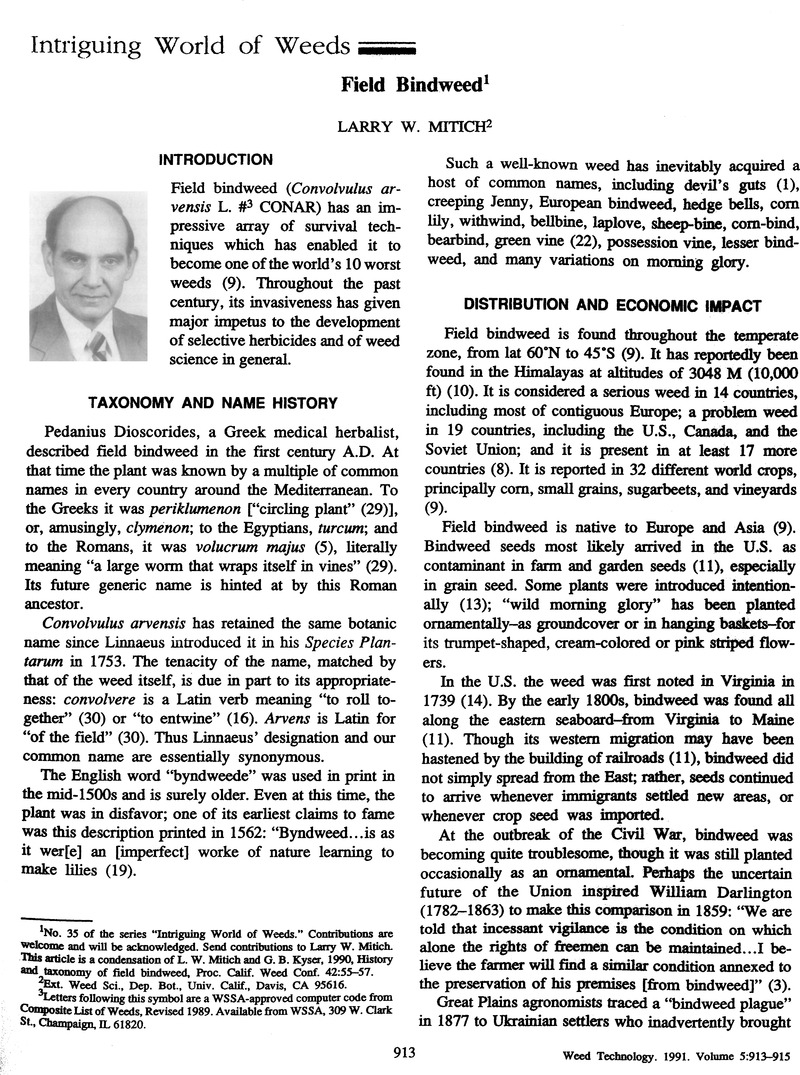Crossref Citations
This article has been cited by the following publications. This list is generated based on data provided by Crossref.
Enloe, Stephen F.
Nissen, Scott J.
and
Westra, Philip
1999.
Absorption, fate, and soil activity of quinclorac in field bindweed (Convolvulus arvensis).
Weed Science,
Vol. 47,
Issue. 2,
p.
136.
Benvenuti, Stefano
Macchia, Mario
and
Miele, Sergio
2001.
Quantitative analysis of emergence of seedlings from buried weed seeds with increasing soil depth.
Weed Science,
Vol. 49,
Issue. 4,
p.
528.
Bryson, Charles T.
2002.
Encyclopedia of Agrochemicals.
Boydston, Rick A.
and
Williams, Martin M.
2004.
Combined effects ofAceria malherbaeand herbicides on field bindweed (Convolvulus arvensis) growth.
Weed Science,
Vol. 52,
Issue. 2,
p.
297.
Rodríguez-Navarro, Silvia
Morell, Héctor Rodríguez
Alemán Martínez, Juan A.
Flores-Macías, Antonio
and
Torres-Martínez, José Gustavo
2011.
Valuation of quality parameters for rearingAceria malherbaeNuzzaci (Acari: Eriophyidae), a biological control agent of field bindweed,Convolvulus arvensisL..
International Journal of Acarology,
Vol. 37,
Issue. 3,
p.
235.
Sosnoskie, Lynn M.
and
Hanson, Bradley D.
2016.
Field Bindweed (Convolvulus arvensis) Control in Early and Late-Planted Processing Tomatoes.
Weed Technology,
Vol. 30,
Issue. 3,
p.
708.
Xiong, Renci
Wang, Ying
Wu, Hanwen
Ma, Yan
Jiang, Weili
and
Ma, Xiaoyan
2018.
Seed treatments alleviate dormancy of field bindweed (Convolvulus arvensisL.).
Weed Technology,
Vol. 32,
Issue. 5,
p.
564.
Sosnoskie, Lynn M.
Hanson, Bradley D.
and
Steckel, Lawrence E.
2020.
Field bindweed (Convolvulus arvensis): “all tied up”.
Weed Technology,
Vol. 34,
Issue. 6,
p.
916.
Kowalczyk, Dariusz
Szymanowska, Urszula
Skrzypek, Tomasz
Bartkowiak, Artur
Materska, Małgorzata
and
Łupina, Katarzyna
2021.
Release of fireweed extract (Epilobium angustifolium L.) from corn starch- and methylcellulose-based films - A comparative study.
Food Hydrocolloids,
Vol. 120,
Issue. ,
p.
106887.
Moretti, Marcelo L.
and
Peachey, R. Edward
2022.
Field bindweed control with quinclorac in highbush blueberry.
Weed Technology,
Vol. 36,
Issue. 2,
p.
197.
Aissa, Idrissi
Chaachouay, Noureddine
Zidane, Lahcen
Fakchich, Jamila
Bussmann, Rainer W.
and
Mostafa, Elachouri
2023.
Ethnobotany of Northern Africa and Levant.
p.
1.
Ma, Xiaoyan
Wu, Hanwen
Ren, Xiangliang
Hu, Hongyan
Wang, Lan
and
Ma, Yan
2023.
Seasonal changes in germinability, dormancy and viability of field bindweed (Convolvulus arvensis) seeds as affected by storage and duration.
Advances in Weed Science,
Vol. 41,
Issue. ,
Idrissi, Aissa
Chaachouay, Noureddine
Zidane, Lahcen
Fakchich, Jamila
Bussmann, Rainer W.
and
Elachouri, Mostafa
2024.
Ethnobotany of Northern Africa and Levant.
p.
915.



